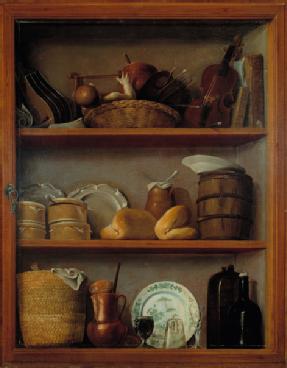Essential Reading 
- Marcy Norton, Sacred Gifts, Profane Pleasures: A History of Tobacco and Chocolate in the Atlantic World (Cornell University Press, 2008). Chapter 7: Commodifying across the Atlantic, pp. 141-172
- Meha Priyadarshini, Chinese Porcelain in Colonial Mexico: The Material Worlds of an Early Modern Trade (Palgrave, 2018). Chapter 3: A Parián in the Plaza Mayor: Making Space for Asia in Colonial Mexico, pp. 97-129
-
Seminar questions
- In what ways were American goods and raw materials adapted and transformed as they crossed the Atlantic? How were they incorporated into daily life and ritual? Choose an example to discuss.
- How were new, global goods (chocolate, tobacco, porcelain, Asian textiles) depicted in Colonial Latin American and Spanish art? What can these images tell us about their assimilation and consumption? What can they convey (and what are they more consciously attempting to communicate) regarding the people and places where these goods were available and consumed?
Further Reading
- Bethany Aram and Bartolomé Yun Casalilla (eds.), Global Goods and the Spanish Empire, 1492-1824: Circulation, Resistance, and Diversity(Basingstoke, 2014). ‘The Spanish Empire, Globalization, and Cross Cultural Consumption in a World Context, c. 1400–c. 1750, pp. 277-306
- Marcy Norton, “Tasting Empire: Chocolate and the European Internalization of Mesoamerican Aesthetics,” American Historical Review, 111 (2006), pp. 660-691.
- Dana Leibsohn, “Made in China/Made in Mexico,” in At the Crossroads: The Arts of Spanish America and Early Global Trade, Donna Pierce and Ronald Otsuka, eds. (Denver: Denver Art Museum, 2012), pp. 11-40.
- Anne Gerritsen and Giorgio Riello (eds.), The Global Lives of Things: The Material Culture of Connections in the Early Modern World(London, 2015). Chapters 4 and 5
- Byron E. Hamann, ‘The Mirrors of Las Meninas: Cochineal, Silver, and Clay,’ The Art Bulletin,92:1-2 (2010), pp. 6–35
- Dana Leibsohn and Meha Priyadarshini, ‘Transpacific: Beyond Silk and Silver,’ The Colonial Latin American Review, 25: 1 (2006), pp.1-15
- Giorgio Riello, ‘Global Things: Europe’s Early Modern Material Transformation, in The Routledge Handbook of Material Culture, (London, 2016), pp. 29-45
- Arnold J. Bauer, Goods, Power, History: Latin America’s Material Culture(CUP, 2001)
- Arjun Appadurai, ed. The Social Life of Things: Commodities in Cultural Perspective(Cambridge, 1986)
- Elena Phipps, ‘The Iberian Globe: Textile Traditions and Trade in Latin America,’ and ‘Global Colours: Dyes and the Dye Trade,’ in Bogansky, A.E. and A. Peck (eds.), Interwoven Globe: The Worldwide Textile Trade, (New York, 2013)
- Alessandra Russo, “Cortés’s objects and the Idea of New Spain: Inventories as Spatial Narratives,” Journal of the History of Collections(2011), pp. 229-252
- Paula Findlen (ed.), Early Modern Things. Objects and their Histories, 1500-1800 (New York, 2013)

